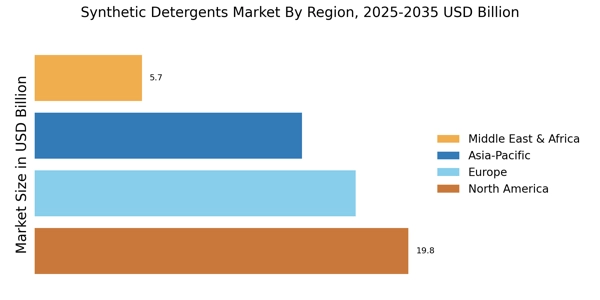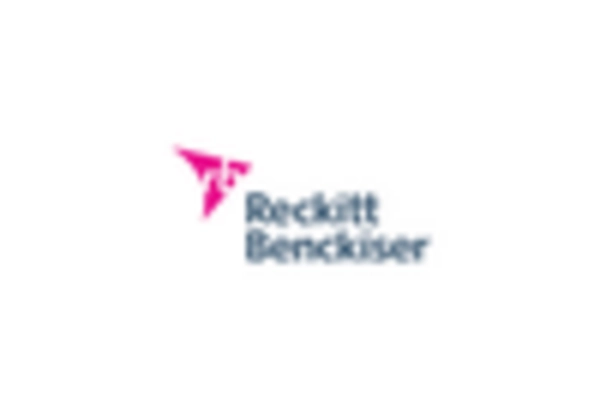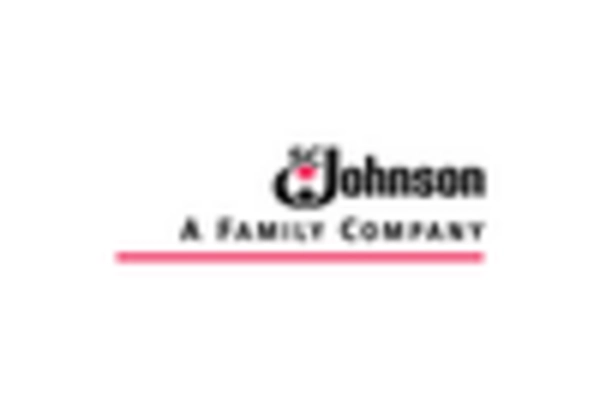Rising Consumer Awareness
The increasing awareness among consumers regarding the environmental impact of cleaning products appears to be a significant driver for the Synthetic Detergents Market. As consumers become more informed about the harmful effects of traditional detergents, they are likely to seek alternatives that are less damaging to the environment. This shift in consumer behavior is reflected in the growing demand for eco-friendly synthetic detergents, which are formulated to minimize ecological footprints. Market data indicates that the eco-friendly segment of the synthetic detergents market is projected to grow at a compound annual growth rate of approximately 7% over the next five years. This trend suggests that manufacturers in the Synthetic Detergents Market may need to innovate and adapt their product lines to meet the evolving preferences of environmentally conscious consumers.
Technological Advancements
Technological advancements in the formulation and production of synthetic detergents are likely to play a crucial role in shaping the Synthetic Detergents Market. Innovations in chemical engineering and materials science have led to the development of more effective and efficient cleaning agents. These advancements not only enhance the performance of synthetic detergents but also contribute to cost reductions in manufacturing processes. For instance, the introduction of enzymes and surfactants that work effectively at lower temperatures has the potential to reduce energy consumption during laundry cycles. Market analysis suggests that the integration of such technologies could lead to a 10% increase in market share for companies that prioritize research and development in the Synthetic Detergents Market. This indicates a competitive landscape where technological prowess may dictate market leadership.
Expansion of Distribution Channels
The expansion of distribution channels is poised to be a vital driver for the Synthetic Detergents Market. With the rise of e-commerce and online shopping platforms, consumers now have greater access to a diverse range of synthetic detergent products. This shift in purchasing behavior is likely to enhance market penetration and increase sales volumes. Additionally, traditional retail channels are also evolving, with supermarkets and convenience stores expanding their product offerings to include a wider variety of synthetic detergents. Market data indicates that online sales of synthetic detergents have increased by 25% in the past year, reflecting a growing preference for convenient shopping options. This trend suggests that manufacturers in the Synthetic Detergents Market may need to invest in robust distribution strategies to capitalize on the expanding market opportunities.
Urbanization and Lifestyle Changes
The ongoing trend of urbanization and changing lifestyles is expected to significantly influence the Synthetic Detergents Market. As more individuals migrate to urban areas, the demand for convenient and effective cleaning solutions is likely to rise. Urban consumers often lead busier lives, which increases their reliance on synthetic detergents for quick and efficient cleaning. Additionally, the rise of dual-income households has further fueled the demand for time-saving products. Market data suggests that urban areas are witnessing a 15% increase in the consumption of synthetic detergents compared to rural regions. This demographic shift indicates that manufacturers in the Synthetic Detergents Market may need to tailor their marketing strategies and product offerings to cater to the specific needs of urban consumers.
Regulatory Support for Eco-Friendly Products
Regulatory frameworks that promote the use of eco-friendly products are emerging as a key driver for the Synthetic Detergents Market. Governments across various regions are implementing stricter regulations on the use of harmful chemicals in cleaning products, thereby encouraging manufacturers to develop safer alternatives. This regulatory support not only fosters innovation but also creates a favorable market environment for synthetic detergents that meet environmental standards. For instance, initiatives aimed at reducing phosphates in detergents have led to a surge in the development of phosphate-free synthetic detergents. Market projections indicate that compliance with these regulations could enhance the market share of eco-friendly synthetic detergents by approximately 20% over the next few years. This trend underscores the importance of regulatory alignment in shaping the future of the Synthetic Detergents Market.


















Leave a Comment